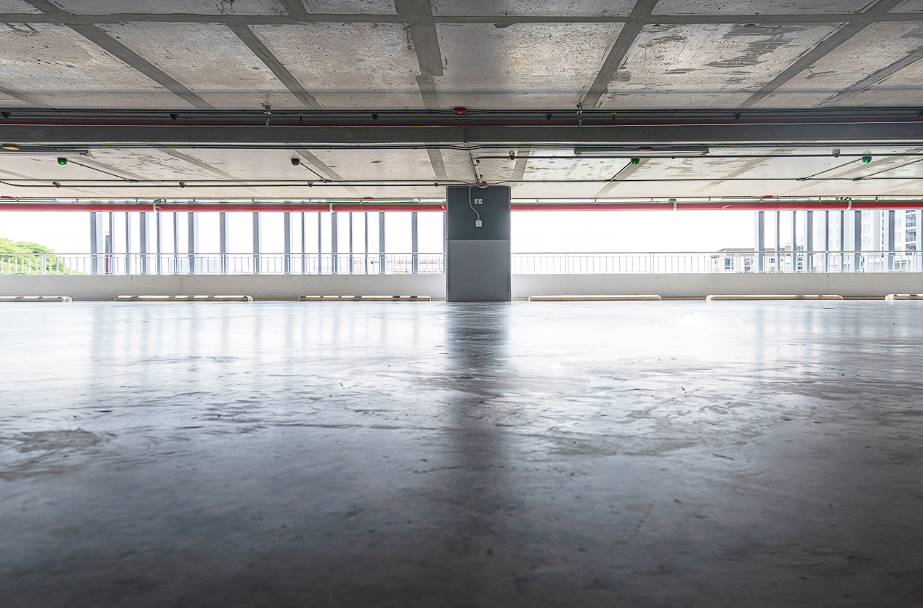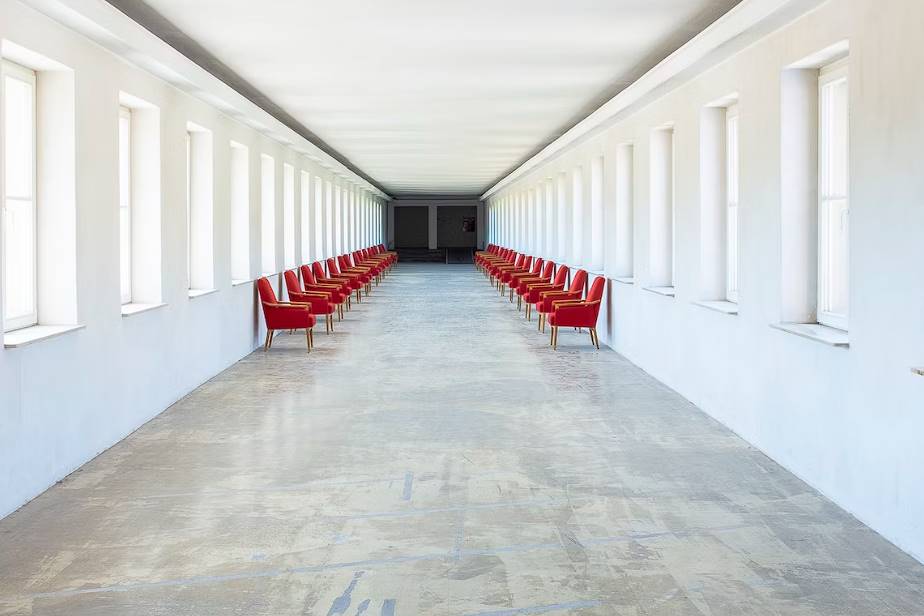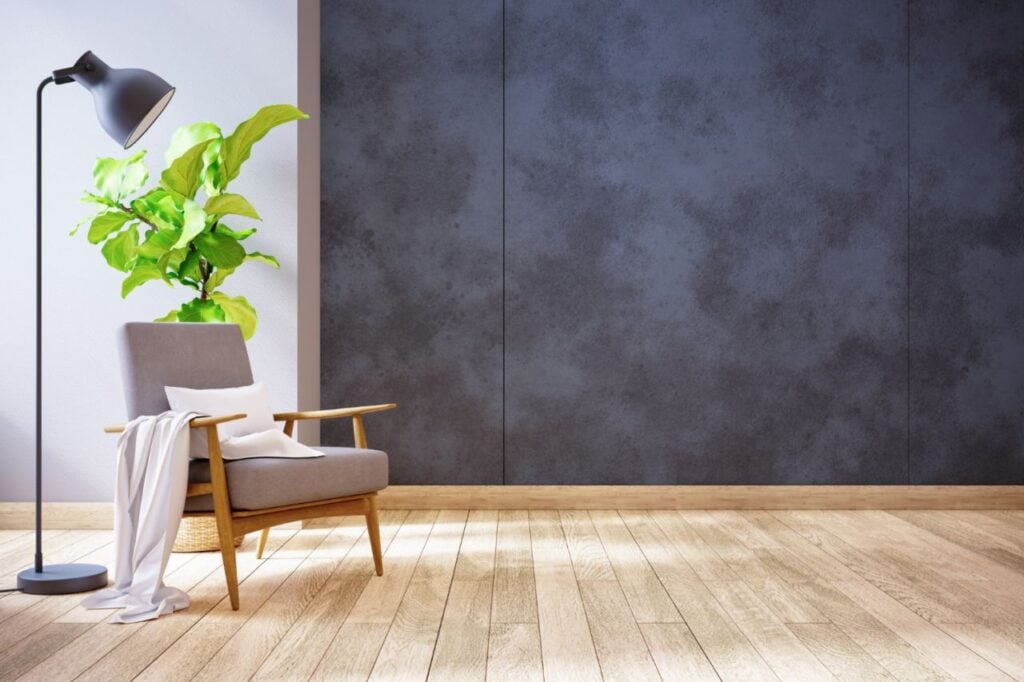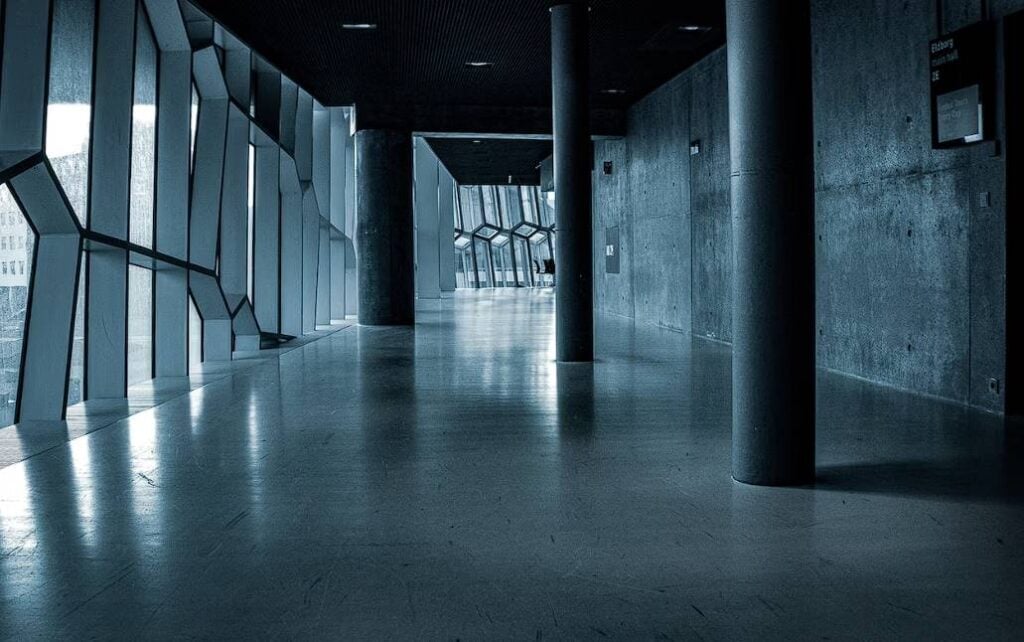Despite the misconception that concrete is limited to a dull grey appearance, it is highly versatile. Various colours and finishes can be applied to concrete surfaces, allowing you to achieve the desired aesthetic for your home or business.
The renewed popularity of polished concrete floors has provided us with many options. In the past, people hesitated to have shiny concrete floors in their homes, reserving polished concrete surfaces for commercial settings. However, times have changed, and polished concrete has become a prominent feature in interior design.
Nevertheless, more clarity still needs to be surrounding the appropriate finish for polished concrete. Contrary to popular belief, there is more than one level of gloss. We have created this guide to demystify polished concrete and explain the different types of finishes available. It discusses the various options concrete contractors provide and how they can enhance your space. We also delve into the design aspects associated with polished concrete.
Without further ado, let's get started!
How to Decide Which Finish to Use on Your Polished Concrete Floors
Attractive flooring plays a crucial role in the overall architectural design of residential and commercial spaces, and polished concrete is a preferred option for numerous reasons. Firstly, it is incredibly versatile, offering a wide range of possibilities.
Concrete polishing is usually customized to individual preferences or specific needs, employing professional techniques to attain the desired level of gloss or shine.
Selecting the perfect finish for a concrete floor can be challenging, but there's no need to fret. We are here to assist you throughout the decision-making process.
What Are Polished Concrete Floors?
Achieving polished concrete floors involves grinding and polishing the concrete until the desired finish is achieved. First, special abrasive grinding tools are utilized to remove layers of concrete, eliminating scratches and other imperfections, followed by finer grinders to create a matte, semi-gloss, or high-gloss appearance.
Additional options for concrete flooring include staining the concrete with specific colours or adjusting the visibility of the aggregate (small particles of stone and sand). Polished concrete is often considered the luxurious choice among concrete floors. However, if you are seeking a more affordable alternative, consider the option of grind and seal.
Grind and seal concrete can provide a similar aesthetic to polished concrete, but there are notable distinctions between the two approaches.
What Types of Concrete Polish Are There?
Collaborating with our team of concrete flooring experts opens up a world of limitless possibilities to design a look that perfectly suits your space. At ACT Restoration, we specialize in developing tailor-made solutions or utilizing proven methods well-suited to your needs.
When it comes to polished concrete, you have a wide array of colours and designs. Additionally, there are four different levels of finish to consider, each influencing the shine and overall appearance of your floor.
Cream Polished Concrete
This type of concrete flooring, often called a "Bronze" finish, is distinguished by its understated appearance. Concrete is polished with diamond pads to bring out its inherent hue rather than ground or honed.
Because no concrete was chipped away, the floor still has its natural variation and texture, which is a plus in terms of aesthetics. This natural and organic style is very popular in residential areas, especially for brand new buildings. You can also stain the concrete if you want to give it a little something extra.
To get that cream finish, your concrete floors must be completely smooth and undamaged. A level surface cannot be achieved without first grinding down any bumps.
As a result, floors made of cream-colored concrete don't show stains or scratches when placed over newly poured concrete. The final look is extremely dependent on the calibre of the concrete blend and the pouring method used.
Industrial
The warehouse finish is commonly preferred when selecting a concrete floor finish for your warehouse or industrial facility. This finish involves a two-step grind and seal process, including a specialized treatment to establish a more durable surface suitable for industrial applications.
Aggregate Finish, Full Or Exposed
Aggregates, for the uninitiated, are the coarse and fine particles like sand and crushed stone that are used in building. In an exposed aggregate finish, the aggregates in the concrete are made visible by grinding away a significant portion of the concrete's surface.
This procedure involves scraping away the top layer of cement paste to reveal the concrete's larger, irregular aggregates below. The bare aggregate that results looks like a slab of granite and has great slip resistance. In addition, it is remarkably resistant to both severe weather and high volumes of foot traffic.
The aggregates' colours range from earthy browns and tans to pinks and reds, depending on their geological origin.
And if you want to give your concrete floors a truly one-of-a-kind look, you can add decorative aggregates. Natural stones such as granite, quartz, limestone, or basalt, as well as recycled coloured glass or seashells, are frequently used.
Full aggregate finishes are superior because of their longevity and the plethora of textured variations they permit. Aggregates are typically blended into the concrete, but they can also be sprinkled on top of the wet mixture and then spread with a bull float. It's a great option because of how long it lasts and how many uses it can serve.
It's worth noting that the cost and effort involved in installing this sort of finish make it more pricy than some other options. If you're considering having exposed aggregate slabs installed, you should probably ask for samples first before committing to a design.
Satin Finish
To achieve a polished and professional showroom finish, we offer an option that involves three additional steps of fine grinding. This process ensures a smoother surface before applying the same acrylic sealer used in the warehouse finish. The result is a satin finish with medium reflectivity, providing a sophisticated appearance for your floors. Moreover, this type of finish is easy to maintain, making it an excellent choice for showroom settings.
Salt And Pepper Finish
Often referred to by its alternative name, "gold" concrete is achieved by lightly grinding the surface to expose the smaller aggregates beneath the surface paste. Aggregates with their finer grains exposed take on a salt-and-pepper appearance.
The salt-and-pepper variety stands out from the exposed-aggregate style because it is polished to a high gloss. In addition, the hue and sheen can be altered to suit your tastes.
Salt-and-pepper polished concrete has the distinct benefit of looking great with both commercial and residential buildings. It's a popular option for commercial spaces like restaurants and shopping centres because of its long lifespan, its ability to reflect light, and the distinctive look it gives floors.
Polished concrete is a common alternative to the more traditional cream concrete for use in home renovations. Salt-and-pepper polished concrete, on the other hand, is more expensive and takes longer to install than cream-polished concrete. Exposing finer aggregates is a complex process that calls for specialised knowledge and should be handled by experts.
Platinum Finish
To achieve the Platinum finish, a similar depth of grinding is required as in the Silver finish, aiming to reveal the ballast within the concrete slab. The resulting pattern is then polished to achieve the highest gloss level available. As a result, the Platinum finish is highly durable and showcases a brilliant shine that reflects light off its glossy surface, creating a magnificent glow. It comes as no surprise that the Platinum finish is among our most sought-after polished concrete options.
Levels Of Gloss
The gloss or shine of a polished concrete floor is a prominent aspect that significantly contributes to its overall appearance and design. While it is often assumed that there is only one type of gloss finish, this is not the case. Therefore, we have compiled the most frequently encountered gloss finishes on polished concrete surfaces to simplify your decision-making process.
It is important to note that a high gloss finish may not be suitable for certain areas, such as bathrooms or living rooms. Therefore, it is advisable to exercise caution and seek professional advice before opting for a specific polished concrete finish for your floor.
Matte
We begin with the timeless matte finish, which imparts a raw and natural appearance to the concrete. This type of finish is highly favoured in restaurants, bars, and cafes that seek a chic rustic ambience while requiring a durable surface capable of enduring heavy foot traffic. The matte finish offers an aesthetically pleasing look, effectively conceals imperfections, and demands relatively low maintenance. It is suitable for warehouses, commercial spaces, and busy households with pets or children, as it provides a less reflective surface that can withstand daily wear and tear.
Semi-polished Or Semi-gloss
The semi-gloss or semi-polished finish is an excellent option if you're seeking a surface that strikes a balance between not being overly glossy yet having a natural sheen. Rest assured, and it is easier than it may initially sound.
Some concrete professionals may refer to it as the satin finish due to its low reflectivity on the surface. Additionally, there are variations within this finish that can lean towards either a flatter or glossier appearance.
Discussing with your contractor to ensure the desired outcome thoroughly is crucial. Typically, achieving this finish involves using abrasive diamond pads up to the 800-grit level during polishing.
A low-gloss look works well in residential interiors and commercial spaces such as automobile showrooms, where the floor should not overpower or clash with other elements present.
High-gloss
Lastly, we explore high-gloss concrete flooring, which offers the utmost shimmer and shine, creating a truly stunning effect on residential and commercial properties.
However, it's important to note that while high-gloss finishes are visually stunning and highly durable, they also tend to reveal dirt, mud, and imperfections more easily. As a result, regular cleaning and maintenance are necessary. Nonetheless, floors with such an impressive appearance deserve extra care and attention.
High-gloss concrete finishes are particularly popular in high-end homes, upscale office spaces, and client meeting rooms, where a luxurious and sophisticated ambience is desired.
Aggregate Exposure
Typically, polished concrete floors are commonly found in a plain grey colour. However, the speckled appearance is also prevalent, particularly in older homes or commercial establishments. This distinctive look is achieved by grinding away the top layer of the concrete to reveal the aggregates—materials like sand and gravel that are added to the concrete mixture.
Below are various finishes of aggregate exposure frequently observed in polished concrete flooring:
Nil Exposure Finish
Among the different polished concrete floor finishes, the nil exposure finish stands out as it does not display any visible aggregate patterning and instead exhibits a matte appearance. Opting for a nil-exposure finish provides your floors with an appealing and consistent tone, creating a luxurious surface that enhances the overall aesthetic of your space.
Minimal Exposure
Have you ever encountered a polished concrete floor with a subtle speckled appearance? If so, you may have encountered what is commonly known as the salt-and-pepper or medium-exposure finish.
Professionals typically employ a delicate grinding technique to achieve this look, carefully removing the top layer of the flooring until the sand or gravel particles become visible. This creates a charmingly speckled pattern on the floor, which can be further enhanced with a high-gloss finish.
Since concrete is poured randomly to form a large slab, the pattern that emerges during grinding is always a delightful surprise.
Full-exposure finish
By applying more extensive grinding on the surface of the concrete, a full-exposure finish can be achieved, showcasing the stones and textures within the concrete. This finish creates a visually impactful statement floor, particularly suited for commercial spaces that aim to make a bold, design-forward, or slightly industrial impression. In addition, the full-exposure finish is characterized by its ability to reveal the inherent beauty and rawness of the concrete, adding a unique and captivating aesthetic to the space.
Conclusion
Polished concrete floors are becoming increasingly popular due to their versatility and ability to achieve the desired aesthetic for a home or business. This guide explains the different types of finishes available and how they can enhance the space. Polished concrete floors involve grinding and polishing the concrete until the desired finish is achieved. There is no need to worry about selecting the perfect finish, as we are here to assist you throughout the decision-making process. Concrete flooring can be polished with special abrasive grinding tools to remove layers of concrete and create a matte, semi-gloss, or high-gloss appearance.
Grind and seal concrete can provide a similar aesthetic, but there are differences between the two approaches. There are four different levels of finish to consider, including cream polished concrete, which is distinguished by its understated appearance and is popular in residential areas. To get that cream finish, concrete floors must be completely smooth and undamaged. The final look of a concrete floor depends on the concrete blend and the pouring method used. Industrial finishes involve a two-step grind and seal process, while aggregate finishes involve grinding away a significant portion of the concrete's surface and adding decorative aggregates.
Satin finishes involve three additional steps of fine grinding before applying an acrylic sealer, providing a polished and professional showroom finish. The cost and effort involved in installing this sort of finish make it more expensive than other options. Salt-and-pepper polished concrete is a popular option for commercial and residential buildings due to its long lifespan, ability to reflect light, and distinctive look. It is more expensive and takes longer to install than cream-polished concrete, and requires specialised knowledge and should be handled by experts. The Platinum finish is highly durable and showcases a brilliant shine that reflects light off its glossy surface.
There are three types of gloss finishes on polished concrete surfaces: Silver, Gold, and Matte. Silver is the most commonly encountered gloss finish, while Gold is the highest gloss level available. The matte finish is suitable for warehouses, commercial spaces, and busy households with pets or children. The semi-polished or semi-gloss finish is a balance between not being overly glossy yet having a natural sheen. High-gloss concrete flooring is visually stunning and highly durable, but requires regular cleaning and maintenance.
Aggregate exposure is usually grey. The speckled appearance of polished concrete flooring is a distinctive look achieved by grinding away the top layer of the concrete to reveal the aggregates. There are various finishes of aggregate exposure, such as nil-exposure, minimal-exposure, and full-exposure. Nil-exposure provides an appealing and consistent tone, while minimal-exposure creates a subtle speckled pattern. Full-exposure is characterized by its ability to reveal the inherent beauty and rawness of the concrete.
Content Summary
- Concrete is highly versatile, with various colors and finishes available.
- Polished concrete floors have gained popularity in interior design.
- Different types of finishes are available for polished concrete.
- Cream polished concrete is popular for residential areas.
- Industrial finish is suitable for warehouses and industrial facilities.
- Aggregate finish exposes the coarse and fine particles in concrete.
- Aggregates can be natural stones or recycled materials.
- Satin finish provides a polished and professional appearance.
- Salt and pepper finish has a high gloss and is popular in commercial spaces.
- Platinum finish offers a brilliant shine and durability.
- There are different levels of gloss available for polished concrete.
- Matte finish has a raw and natural appearance, suitable for heavy foot traffic areas.
- Semi-polished or semi-gloss finish strikes a balance between gloss and natural sheen.
- High-gloss finish creates a stunning effect but requires regular maintenance.
- Aggregate exposure in polished concrete can vary.
- Nil exposure finish provides a matte appearance without visible aggregates.
- Minimal exposure finish has a subtle speckled appearance.
- Full-exposure finish showcases the stones and textures within the concrete.
- Different finishes can enhance the aesthetic of a space.
- Polished concrete is a popular choice for residential and commercial spaces.
- Grind and seal concrete is a more affordable alternative to polished concrete.
- Collaborating with concrete flooring experts allows for customized solutions.
- Concrete polishing involves grinding and polishing the concrete surface.
- Staining and adjusting the visibility of aggregate are additional options for concrete flooring.
- The cost and effort of installing certain finishes may vary.
- Professional advice is recommended when choosing a specific polished concrete finish.
- Matte finish is suitable for restaurants, bars, and cafes.
- High-gloss finish is popular in high-end homes and upscale office spaces.
- Regular cleaning and maintenance are necessary for high-gloss finishes.
- Different finishes offer unique and captivating aesthetics for a space.
Frequently Asked Questions
Stamped concrete is the most expensive form of concrete finishing due to the time involved in carefully and uniformly placing the stamped pattern. Stamped concrete, however, achieves a highly aesthetic look that is perfect for applications such as outdoor patios.
The trowel finish is the most popular and smoothest concrete finish. After the concrete is laid, a trowel is used to smoothen out the fine-level concrete surface.
Extreme temperature changes can cause the concrete to expand and contract, leading to cracks or surface damage. Heavy foot traffic, especially with hard or pointed shoes, can cause scratches or scuffs on the surface. Chemical spills such as oil or cleaning solutions can cause discolouration or staining.
Polished concrete is preferred over epoxy flooring because of its compressive strength, beautiful look, and resistance to toxic chemicals and substances. In addition, polished concrete flooring is ideal for garages that will not be subjected to harsh chemicals and materials of extreme pH substances.
Mechanically polished concrete (Hiperfloor) can be walked on immediately after completion. However, no water should be applied to the floor for three days, so be sure that you keep the floor dry for the first 72 hours.







